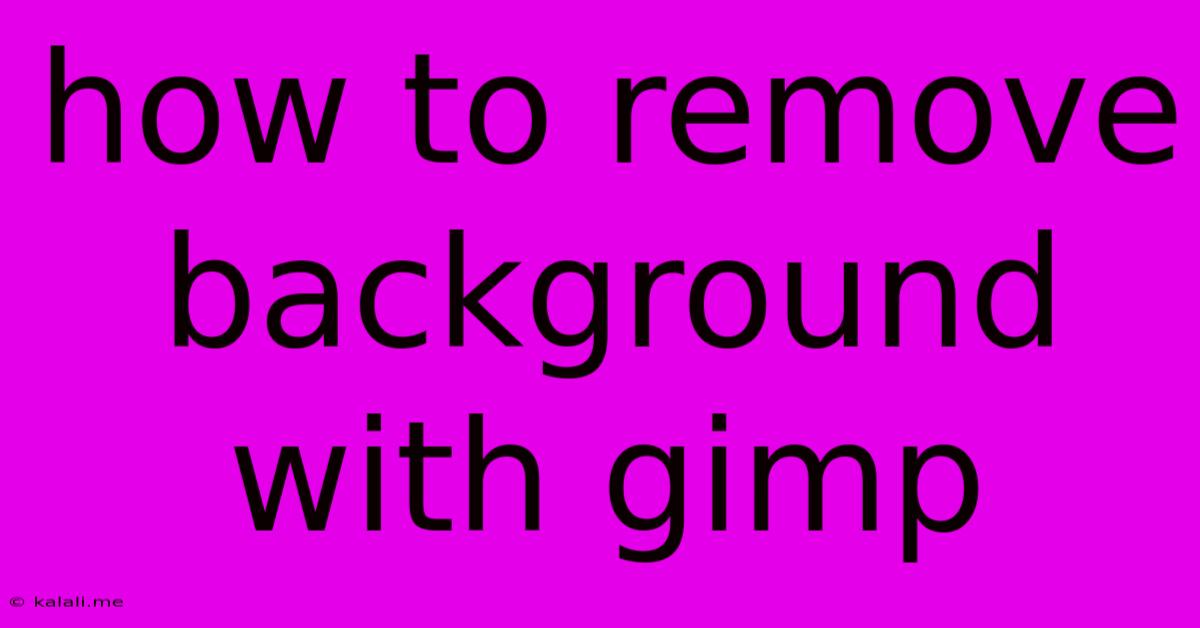How To Remove Background With Gimp
Kalali
Jun 05, 2025 · 4 min read

Table of Contents
How to Remove a Background in GIMP: A Comprehensive Guide
Removing a background in GIMP is a crucial skill for anyone working with images, whether you're creating product mockups, designing logos, or simply enhancing photos. This guide provides a step-by-step walkthrough of several effective methods, catering to different image complexities and skill levels. We'll cover using the Foreground Select Tool, the Fuzzy Select Tool, and the Path Tool, offering flexibility for various situations. Learn how to achieve professional-looking results, even with a free and open-source program like GIMP.
Method 1: Using the Foreground Select Tool (For Simple Backgrounds)
This method is ideal for images with a stark contrast between the subject and the background. It's perfect for removing backgrounds that are uniformly colored or easily separable from the main subject.
- Open your image: Launch GIMP and open the image you want to edit.
- Select the Foreground Select Tool: Find it in the toolbox on the left-hand side. It's represented by a magic wand icon.
- Adjust the Threshold: The threshold setting determines the sensitivity of the selection. A lower threshold selects areas with similar colors, while a higher threshold selects areas with more contrasting colors. Experiment to find the optimal setting for your image.
- Click on the foreground: Click on the area you want to keep (your subject). The tool will automatically select similar pixels.
- Refine the Selection (Optional): Use the selection tools (like the "Add to the current selection" or "Subtract from the current selection") to refine the selection. Add any missed parts of the subject and subtract any unwanted background areas.
- Invert the Selection: Go to
Select>Invert. This selects the background. - Delete the Background: Press the
Deletekey on your keyboard. - Save your Image: Go to
File>Export Asand save your image in the desired format (e.g., PNG for transparency).
Method 2: Using the Fuzzy Select Tool (For More Complex Backgrounds)
The Fuzzy Select Tool is more versatile than the Foreground Select Tool, handling images with more nuanced backgrounds and varying colors.
- Open your image and select the Fuzzy Select Tool: Find the Fuzzy Select Tool in the toolbox (it looks like a magnifying glass with a plus sign).
- Adjust the Threshold and Radius: The threshold controls color similarity, while the radius defines the selection's sensitivity to nearby pixels. Experiment with these settings for optimal results. A smaller radius is generally better for detailed images.
- Click on the subject: Click on the area you want to keep. The tool will select similar pixels based on your settings.
- Refine the Selection: Use the selection tools ("Add to the current selection," "Subtract from the current selection," and "Select by color") to carefully adjust your selection, including any missed parts and excluding unwanted sections. Zoom in for precision.
- Create a Layer Mask: Right-click on the layer in the Layers panel and select
Add Layer Mask. ChooseSelectionas the mask source. This preserves your original image while allowing you to edit the background. - Delete the background: Use the eraser tool with a soft brush to clean up any remaining background imperfections around the edges of your subject.
- Save your Image: Save your image with transparency (PNG).
Method 3: Using the Paths Tool (For Precise Background Removal)
For intricate images requiring pixel-perfect precision, the Paths Tool offers ultimate control.
- Open your image and select the Paths Tool: Find it in the toolbox (it looks like a pen).
- Create a Path: Carefully trace around your subject, creating a path that precisely outlines its edges. Use the zoom tool to achieve the finest detail.
- Select the path: Right-click on the path and select
Selection from Path. - Invert the Selection: Go to
Select>Invert. - Delete the background: Press the
Deletekey. - Save your Image: Save your image with transparency.
These three methods provide a solid foundation for background removal in GIMP. Remember that practice is key. Experiment with different tools and settings to master the techniques and achieve professional-looking results. Don't be afraid to undo steps and try again! The beauty of GIMP is its non-destructive editing capabilities, allowing you to experiment freely.
Latest Posts
Latest Posts
-
Dnd Death Ward How Long Does It Last
Jun 07, 2025
-
Does Greyhound Accept Prison Id Bracelets In Virginia
Jun 07, 2025
-
Why Did Eren Fight Alongside Zeke
Jun 07, 2025
-
How To Send Prompt To Chatgpt With A Query String
Jun 07, 2025
-
How To Find A Key Fob
Jun 07, 2025
Related Post
Thank you for visiting our website which covers about How To Remove Background With Gimp . We hope the information provided has been useful to you. Feel free to contact us if you have any questions or need further assistance. See you next time and don't miss to bookmark.